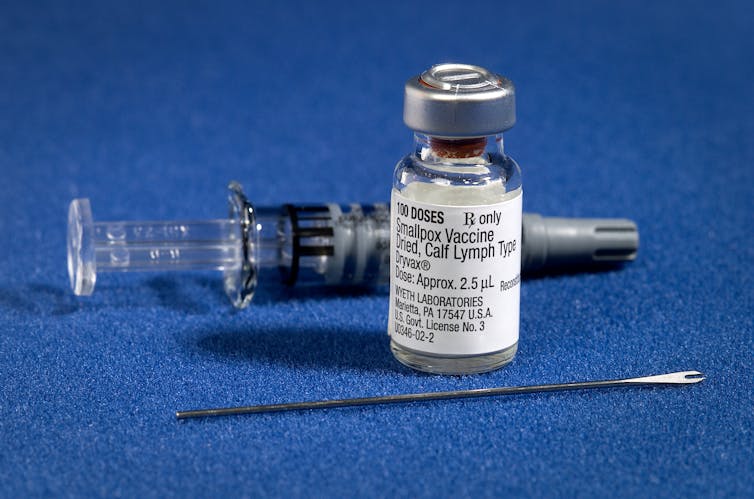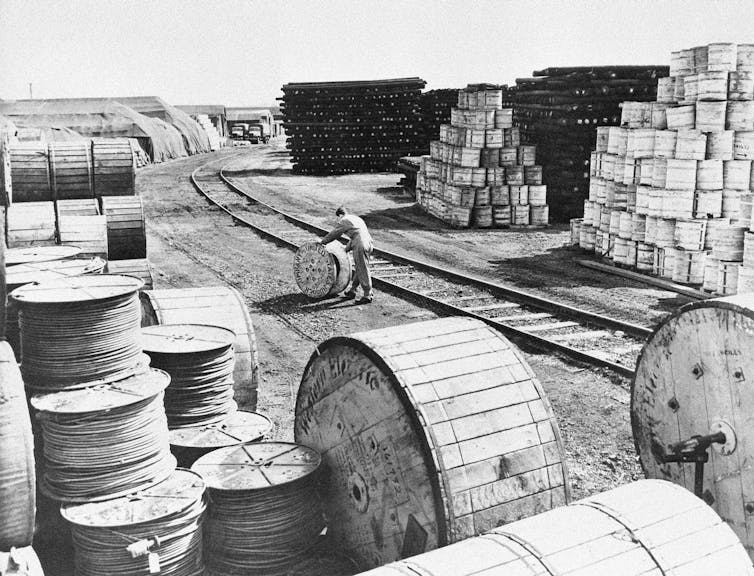Coronavirus: Strategic National Stockpile was ready, but not for this
- Written by Andrew Lakoff, Professor of Sociology, University of Southern California – Dornsife College of Letters, Arts and Sciences
As the COVID-19 crisis unfolds, Americans have been hearing a lot about an obscure but vast federal trove of emergency supplies, the Strategic National Stockpile[1].
Much of the discussion concerns its shortcomings. Hospitals and first responders have faced dire shortages[2] of critical equipment such as ventilators and protective masks. It is clear that the national stockpile does not have nearly enough of such supplies[3] to meet the present need.
Meanwhile, there are plenty of things in the stockpile that aren’t particularly helpful right now – botulism antitoxin, for instance, and millions of doses of smallpox vaccine. As a scholar[4] who focuses on the role of expert knowledge in addressing an uncertain future[5], I have long been interested in how decisions are made about what to put into the Strategic National Stockpile.
The question of what to store in case of an emergency points to a broader issue: how security and health officials decide which threats are most urgent to prepare for. This is a matter of collective judgment rather than technical calculation.
Figuring out what to prepare for
The overall contents of the national stockpile are classified, as are its locations. But some details are available in journalistic accounts[6] and governmental reports[7], including the existence of at least six large warehouses scattered in different parts of the country. It was managed by the U.S. Centers for Disease Control and Prevention before being transferred to the assistant secretary for preparedness and response in the Department of Health and Human Services in 2018.
The Strategic National Stockpile was established in 1999, as health and security officials in the Clinton administration became increasingly worried about the massive stocks of anthrax and smallpox that the Soviet Union had accumulated[8]. As the Soviet government collapsed and the Cold War ended, it was not clear where all those weaponized pathogens had gone – or who had them. For this reason, much of the Strategic National Stockpile consists of boxes and vials of countermeasures to address potential bioweapon attacks.
In 2001, a policy planning exercise called “Dark Winter,” conducted by a group of public officials at Andrews Air Force Base in Maryland, simulated a devastating smallpox attack on the United States. According to the scenario[9], developed by a D.C.-based biosecurity think tank, a shortage of smallpox vaccine led to widespread civil unrest and political breakdown. Participants were not able to contain the simulated outbreak using existing public health and policy measures.
In the aftermath of the exercise, officials added enough smallpox vaccine to the Strategic National Stockpile to be able to inoculate the entire U.S. population[10]. The assumption was that to avoid the breakdown seen in “Dark Winter,” the country would need to have sufficient vaccine available in advance of a future smallpox attack.
 One small vial can contain 100 doses of a smallpox vaccine.
James Gathany/CDC/Wikimedia Commons[11]
One small vial can contain 100 doses of a smallpox vaccine.
James Gathany/CDC/Wikimedia Commons[11]
New concerns arise
But security officials were also concerned about other potential threats. To respond in the event of a chemical attack, the stockpile accumulated 2,000 packages[12] of nerve agent antidote[13].
To address the threat of an anthrax attack, it acquired stocks of a novel anthrax vaccine procured from a biotechnology company under a US$1.5 billion contract[14] with the government’s Biomedical Advanced Research and Development Authority.
In the mid-2000s, planners began to focus on the possibility that the highly virulent H5N1 bird flu[15] would mutate to become easily transmissible among humans. They added millions of doses[16] of antiviral drugs – effective for flu, but not the coronavirus – and influenza vaccine to the stockpile.
Much of the effort and money – an annual budget of around $600 million – involved in maintaining the Strategic National Stockpile is devoted to ensuring that these biomedical countermeasures are stored properly and kept up-to-date.
Unknowns remain
As a result of all those efforts, the Strategic National Stockpile built up over the last 20 years was well-prepared for a range of possible threats – just not for the event that actually occurred.
One lesson is that stockpiling is not just a matter of storing large quantities of supplies and equipment; it also requires considering the larger question of which dangers are most pressing to address. Exercises and simulations can tell security planners where vulnerabilities lie in the present, but they cannot reveal what will actually occur in the future.
Given the current emphasis on maintaining limited inventories and carefully calibrated supply chains designed to deliver things only when they are needed, it may seem antiquated to store large amounts of supplies to remain available over an indefinite time horizon.
In fact, this type of government stockpiling of essential supplies is rooted in the era of industrial mobilization for total war[17], when nations’ entire economies were converted to support a massive war effort.
 A stockpile of telecommunications equipment in Britain is ready for use after the invasion of Normandy in 1944.
AP Photo[18]
A stockpile of telecommunications equipment in Britain is ready for use after the invasion of Normandy in 1944.
AP Photo[18]
Waging an uncertain war
The term “stockpile” did not come into common use until the ramp-up to World War II.
As part of its industrial mobilization effort, the U.S. government began storing large quantities of “critical and strategic materials[19]” – basic industrial ingredients like copper, tungsten and rubber – in anticipation of a cut-off of foreign supplies. After the war, government stockpiling expanded to include supplies necessary for the maintenance of civilian life, such as electrical generators, oil, food and medicine.
During the Cold War, the U.S. maintained an extensive medical stockpile designed for use in the aftermath of a nuclear attack. By 1955, the civil defense medical stockpile contained[20] 9 million doses of penicillin, 33 million capsules of broad-spectrum antibiotics, 2 million sets for collecting and transfusing whole blood, 132,000 radiological monitoring instruments, and over 25 million doses of vaccines and antitoxins for controlling communicable diseases and defending against biological warfare.
These supplies were located in 32 storage sites around the country, in small communities located within four hours’ drive of major cities.
However, as weapons became more powerful, the public grew increasingly skeptical that nuclear war could be survived. As a result, congressional support for maintaining the stockpile diminished.
By the late 1960s, over $100 million in unused medical supplies were gradually deteriorating in storage facilities around the country. The federal government disposed of its entire medical stockpile and closed down the program[21] in 1974.
It was not until the late 1990s, in the face of the newly perceived threat of bioterrorism, that the U.S. government returned to the technique of stockpiling medical supplies for a future calamity.
Today, the Strategic National Stockpile is designed to protect the population against a wide range of potential threats – but does not have enough of what is needed to fight the coronavirus pandemic.
This points to the limitations of stockpiling as a measure of security. Stockpiled supplies inevitably degrade or become obsolete; the maintenance of a stockpile is continually subject to budgetary struggles, in part because it is impossible to know whether its supplies will ever be needed. The stockpile is assembled in preparation for a particular imagined future, but the actual future rarely turns out as anticipated.
[Get facts about coronavirus and the latest research. Sign up for our newsletter.[22]]
References
- ^ Strategic National Stockpile (www.phe.gov)
- ^ dire shortages (www.washingtonpost.com)
- ^ enough of such supplies (www.nytimes.com)
- ^ scholar (scholar.google.com)
- ^ expert knowledge in addressing an uncertain future (www.ucpress.edu)
- ^ journalistic accounts (www.washingtonpost.com)
- ^ governmental reports (www.ncbi.nlm.nih.gov)
- ^ Soviet Union had accumulated (www.nytimes.com)
- ^ scenario (www.centerforhealthsecurity.org)
- ^ the entire U.S. population (www.naccho.org)
- ^ James Gathany/CDC/Wikimedia Commons (commons.wikimedia.org)
- ^ 2,000 packages (www.phe.gov)
- ^ nerve agent antidote (www.washingtonpost.com)
- ^ US$1.5 billion contract (homelandprepnews.com)
- ^ H5N1 bird flu (doi.org)
- ^ millions of doses (webapps.cap.org)
- ^ mobilization for total war (www.nap.edu)
- ^ AP Photo (www.apimages.com)
- ^ strategic materials (www.nap.edu)
- ^ civil defense medical stockpile contained (www.ncbi.nlm.nih.gov)
- ^ closed down the program (www.nytimes.com)
- ^ Sign up for our newsletter. (theconversation.com)
Authors: Andrew Lakoff, Professor of Sociology, University of Southern California – Dornsife College of Letters, Arts and Sciences

